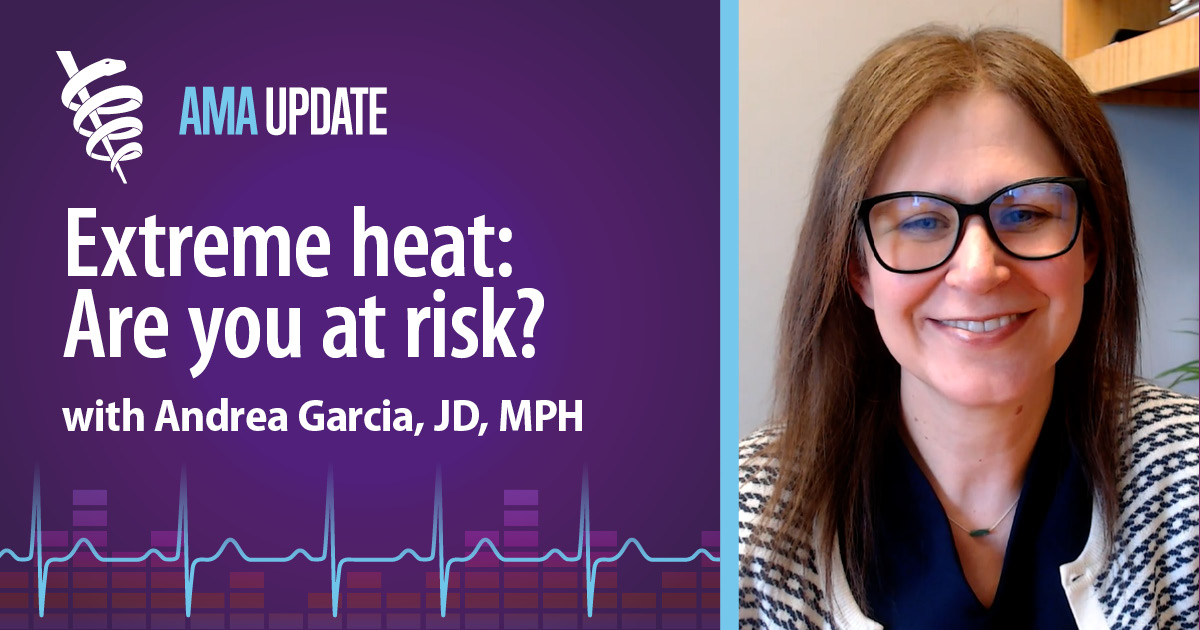CDC heat risk initiative, air pollution statistics and the latest news on bird flu in milk
CDC heat risk initiative, air pollution statistics and the latest news on bird flu in milk American Medical Association


AMA Update: Heat Guidance and Air Pollution

AMA Update covers a range of health care topics affecting the lives of physicians, residents, medical students and patients. From private practice and health system leaders to scientists and public health officials, hear from the experts in medicine on COVID-19, medical education, advocacy issues, burnout, vaccines and more.
Featured topic and speakers
- Andrea Garcia, JD, MPH, vice president, science, medicine & public health, American Medical Association
Transcript
Unger: Hello and welcome to the AMA Update video and podcast. Today, we have our weekly look at the headlines with the AMA’s Vice President of Science, Medicine and Public Health, Andrea Garcia. I’m Todd Unger, AMA’s chief experience officer. Welcome back, Andrea.
Garcia: Thanks, Todd, I appreciate the opportunity to be here.
Unger: Well, in addition to looking forward to summer and possibly cicadas here in Chicago, there is the possibility of, of course, extreme heat, and we’re going to begin today’s discussion with new heat guidance that was just released by the CDC. Andrea, tell us more about it and why it’s needed right now.
Garcia: Well, Todd, hard heat-related illness has really been a growing public health concern both here and worldwide for some time now. Extreme heat events are becoming more frequent and more intense, and it really doesn’t matter what state you live in. More than two-thirds of all people in the U.S. were under a heat alert at some point in 2023. And a recent report from the CDC found that daily emergency department visits due to heat-related illness peaked in several regions over the warm season months in 2023, and then they remained exceedingly high for an extended duration.
As you can imagine, these conditions can be especially dangerous for people with underlying health conditions. So in response to those increased health risks, the CDC, in partnership with the National Oceanic and Atmospheric Administration, or NOAA—there’s National Weather Service—launched a new Heat and Health Initiative which is designed to protect people from heat exposure. And the CDC Director, Dr. Mandy Cohen, said heat can impact our health, but heat-related illness and death are preventable.
Heat Risk Forecast Tool
- The Heat Risk Forecast Tool provides location-specific seven-day heat forecast that tells people when temperatures may reach levels that could harm their health.
Heat Risk Dashboard
- The Heat Risk Dashboard allows anyone to enter their zip code, receive a personalized heat forecast for their location and actions they can take to stay safe.
Clinical Guidance
- The CDC’s clinical guidance was developed to help health care professionals speak with their patients about heat and reduce the risk of negative health impacts due to heat exposure with special considerations for people with heart disease, children with asthma, and pregnant women.
Unger: Andrea, tell us a little bit more about the initiative. Is it targeting patients or physicians?
Garcia: It’s really targeting both and public health officials, too. So the initiative offers three new resources that, when combined, can help people be prepared, stay cool, stay hydrated and recognize the symptoms of heat-related illness. One resource is the Heat Risk Forecast Tool, and that provides location-specific seven-day heat forecast that tells people when temperatures may reach levels that could harm their health.
The methodology created by the CDC and NOAA pulls together health and temperature data to deliver that seven-day outlook. They use a five-level scale and the tool indicates how risky the heat level is in a specific area. The tool was really designed for public health audiences, including state and local health officials, and can help jurisdictions in implementing their heat response plans.
Unger: Now you mentioned there were three tools. What’s the second tool and who’s it for?
Garcia: Well, using data from the Heat Risk Forecast Tool, the CDC also created a Heat Risk Dashboard, and that was designed for the general public. That dashboard allows anyone to enter their zip code, receive a personalized heat forecast for their location and actions they can take to stay safe. That dashboard provides information on local air quality and other important heat and health information, and that’s alongside new clinical guidance for people at higher risk who may need to take more protective actions.
Unger: Now given this is a pretty widespread problem, obviously we need to arm physicians with the proper information and guidance. What do physicians need to know now?
Garcia: Well, even though he can impact anyone’s physical and mental health, children, especially those with asthma, pregnant women, older adults, and those with cardiovascular disease among other groups may be at greater risk of heat-related illness. The CDC’s clinical guidance was developed to help health care professionals speak with their patients about heat and reduce the risk of negative health impacts due to heat exposure with special considerations for people with heart disease, children with asthma, and pregnant women.
That guidance helps doctors talk to patients about the negative health impacts of heat exposure and provides them with simple steps they can take to stay safe, and we’ll include links in the description of this episode where physicians can find out more.
Air Pollution and Health
Unger: All right, Andrea. Thank you so much for that update. I mean, we’ve been talking about extreme heat and heat-related illnesses, but you also mentioned issues around air quality. Sometimes those go hand-in-hand, it seems, but a new report suggests that many of us are living in places with unhealthy levels of air pollution. Andrea, what can you tell us about that?
Garcia: Yeah, Todd, there was a new report from the American Lung Association which showed that nearly 40% of people in the U.S. are living in places with unhealthy levels of air pollution. And just to put that percentage into context, the number of people living with levels of air pollution that can significantly affect their health increased from about 119 million in last year’s data to 131 million in the current data.SDGs, Targets, and Indicators
| SDGs | Targets | Indicators |
|---|---|---|
| SDG 3: Good Health and Well-being | Target 3.9: By 2030, substantially reduce the number of deaths and illnesses from hazardous chemicals and air, water, and soil pollution and contamination | Indicator 3.9.1: Mortality rate attributed to household and ambient air pollution |
| SDG 11: Sustainable Cities and Communities | Target 11.6: By 2030, reduce the adverse per capita environmental impact of cities, including by paying special attention to air quality and municipal and other waste management | Indicator 11.6.2: Annual mean levels of fine particulate matter (e.g. PM2.5) in cities (population weighted) |
| SDG 13: Climate Action | Target 13.1: Strengthen resilience and adaptive capacity to climate-related hazards and natural disasters in all countries | Indicator 13.1.1: Number of deaths, missing persons, and directly affected persons attributed to disasters per 100,000 population |
1. Which SDGs are addressed or connected to the issues highlighted in the article?
The SDGs that are addressed or connected to the issues highlighted in the article are:
- SDG 3: Good Health and Well-being
- SDG 11: Sustainable Cities and Communities
- SDG 13: Climate Action
2. What specific targets under those SDGs can be identified based on the article’s content?
The specific targets under those SDGs that can be identified based on the article’s content are:
- Target 3.9: By 2030, substantially reduce the number of deaths and illnesses from hazardous chemicals and air, water, and soil pollution and contamination (SDG 3)
- Target 11.6: By 2030, reduce the adverse per capita environmental impact of cities, including by paying special attention to air quality and municipal and other waste management (SDG 11)
- Target 13.1: Strengthen resilience and adaptive capacity to climate-related hazards and natural disasters in all countries (SDG 13)
3. Are there any indicators mentioned or implied in the article that can be used to measure progress towards the identified targets?
Yes, there are indicators mentioned or implied in the article that can be used to measure progress towards the identified targets:
- Indicator 3.9.1: Mortality rate attributed to household and ambient air pollution (SDG 3)
- Indicator 11.6.2: Annual mean levels of fine particulate matter (e.g. PM2.5) in cities (population weighted) (SDG 11)
- Indicator 13.1.1: Number of deaths, missing persons, and directly affected persons attributed to disasters per 100,000 population (SDG 13)
4. SDGs, Targets, and Indicators
| SDGs | Targets | Indicators |
|---|---|---|
| SDG 3: Good Health and Well-being | Target 3.9: By 2030, substantially reduce the number of deaths and illnesses from hazardous chemicals and air, water, and soil pollution and contamination | Indicator 3.9.1: Mortality rate attributed to household and ambient air pollution |
| SDG 11: Sustainable Cities and Communities | Target 11.6: By 2030, reduce the adverse per capita environmental impact of cities, including by paying special attention to air quality and municipal and other waste management | Indicator 11.6.2: Annual mean levels of fine particulate matter (e.g. PM2.5) in cities (population weighted) |
| SDG 13: Climate Action | Target 13.1: Strengthen resilience and adaptive capacity to climate-related hazards and natural disasters in all countries | Indicator 13.1.1: Number of deaths, missing persons, and directly affected persons attributed to disasters per 100,000 population |
Copyright: Dive into this article, curated with care by SDG Investors Inc. Our advanced AI technology searches through vast amounts of data to spotlight how we are all moving forward with the Sustainable Development Goals. While we own the rights to this content, we invite you to share it to help spread knowledge and spark action on the SDGs.
Fuente: ama-assn.org

Join us, as fellow seekers of change, on a transformative journey at https://sdgtalks.ai/welcome, where you can become a member and actively contribute to shaping a brighter future.







